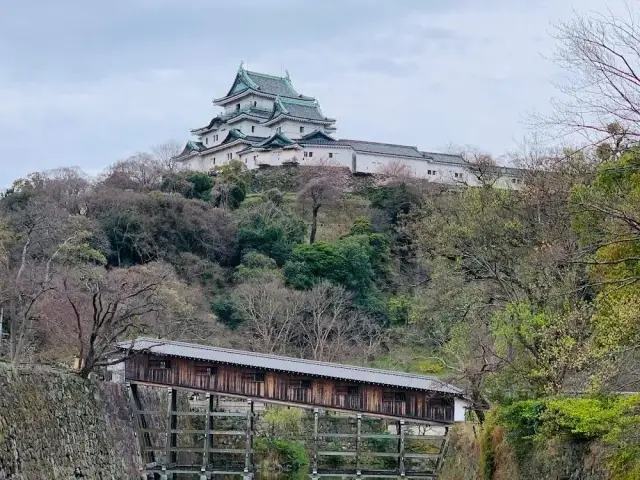https://www.dekitabi.com/itinerary/wakayama-castle-coast-tour
Nestled in the picturesque region of Wakayama Prefecture, Wakayama City offers an array of historical and scenic attractions that captivate the hearts of travelers. From the majestic Wakayama Castle to the serene gardens and ancient shrines, this guide will take you on a journey through some of Wakayama’s most enchanting sites. Perfect for history enthusiasts, nature lovers, and cultural explorers, these destinations promise a memorable experience.
Wakayama Castle: A Majestic Fortress

https://www.dekitabi.com/itinerary/wakayama-castle-coast-tour
Wakayama Castle stands as a symbol of the city’s rich history and architectural grandeur. Originally constructed in 1585 by Toyotomi Hidenaga, the castle has witnessed numerous reconstructions and restorations over the centuries. Perched on Torafusu Hill, it offers panoramic views of the city and the Kii River.
The castle’s keep, with its elegant white walls and black tiles, is a striking example of traditional Japanese castle architecture. Inside, visitors can explore the museum, which houses artifacts and exhibits related to the castle’s history and the Tokugawa family, who once ruled the area. The surrounding Nishinomaru Garden, with its beautiful cherry blossoms in spring, adds to the castle’s charm, making it a must-visit for history buffs and photographers alike.
Momijidani Garden: A Tranquil Retreat

https://www.dekitabi.com/attraction/momijidani-garden
Just a stone’s throw from Wakayama Castle lies Momijidani Garden, a serene haven known for its stunning autumn foliage. The name “Momijidani” translates to “Valley of Maple Trees,” and true to its name, the garden bursts into vibrant hues of red and orange during the fall season.
Designed in the traditional Japanese stroll-garden style, Momijidani Garden features winding paths, tranquil ponds, and meticulously maintained landscapes. The garden’s central pond, spanned by a graceful bridge, reflects the changing seasons and provides a peaceful spot for reflection and relaxation. Whether you’re visiting in autumn or any other season, the garden’s beauty and tranquility offer a perfect escape from the hustle and bustle of city life.
Muryokoji Temple: A Hidden Gem

https://www.dekitabi.com/attraction/muryokoji-wakayama
Tucked away in the hills of Wakayama, Muryokoji Temple is a hidden gem that offers a glimpse into Japan’s spiritual heritage. Founded in the Heian period, this Buddhist temple is dedicated to Amida Nyorai, the Buddha of Infinite Light.
The temple complex is renowned for its serene atmosphere and beautiful gardens, which include a pond filled with lotus flowers and a grove of ancient trees. The main hall, with its rustic wooden architecture, houses a statue of Amida Nyorai and other important cultural artifacts. Visitors can partake in meditation sessions and experience the peaceful ambiance that has attracted monks and pilgrims for centuries.
Saikazaki Lighthouse: A Coastal Beacon

https://www.dekitabi.com/attraction/saikazaki-signal-tower
Located on the scenic Saikazaki Peninsula, Saikazaki Lighthouse offers breathtaking views of the Pacific Ocean and the surrounding coastline. Built in 1866, this historic lighthouse is one of the oldest Western-style lighthouses in Japan.
The lighthouse stands on a rugged cliff, providing a dramatic backdrop for photography enthusiasts. From the observation deck, you can gaze out at the endless sea and watch as fishing boats and cargo ships navigate the waters. The nearby fishing village of Saikazaki adds to the charm of the area, with its quaint streets and fresh seafood markets.
Bandoko Garden: A Seaside Sanctuary

https://www.dekitabi.com/attraction/bandoko-garden
Bandoko Garden, located near Saikazaki Lighthouse, is a seaside garden that combines natural beauty with historical significance. The garden was originally part of the summer retreat of the Kishu Tokugawa family, who ruled the region during the Edo period.
Today, Bandoko Garden is a popular spot for both locals and tourists, offering stunning views of the ocean and a variety of seasonal flowers. The garden’s rocky coastline and clear waters make it an ideal location for a leisurely stroll or a picnic. Don’t miss the Bandoko-no-Matsu, a large pine tree that has become a symbol of the garden and a favorite subject for photographers.
Kishu Toshogu Shrine: A Glimpse into the Past

https://www.dekitabi.com/attraction/kishu-toshogu-shrine
Kishu Toshogu Shrine, located at the foot of Mount Nagusa, is a historic site dedicated to Tokugawa Ieyasu, the founder of the Tokugawa shogunate. The shrine, built in the 17th century, is one of the many Toshogu shrines found across Japan, and it reflects the architectural style and grandeur of the Edo period.
Visitors to Kishu Toshogu Shrine can explore its beautifully decorated buildings, including the main hall, which is adorned with intricate carvings and gold leaf. The shrine is surrounded by a lush forest, providing a peaceful and spiritual atmosphere. Annual festivals and rituals held at the shrine attract numerous visitors and offer a glimpse into traditional Japanese culture and customs.
Wakaura Tenmangu Shrine: A Cultural Treasure

https://www.dekitabi.com/attraction/wakaura-tenmangu-shrine
Wakaura Tenmangu Shrine, located near the scenic Wakaura Bay, is another cultural treasure of Wakayama. This Shinto shrine is dedicated to Sugawara no Michizane, a revered scholar and poet from the Heian period, who is worshipped as the deity of learning and education.
The shrine complex features several impressive structures, including the main hall and the Romon gate, which are designated as Important Cultural Properties. The surrounding area is known for its natural beauty, with cherry blossoms in spring and colorful foliage in autumn. Students and scholars often visit Wakaura Tenmangu Shrine to pray for academic success and inspiration.


Leave a Reply